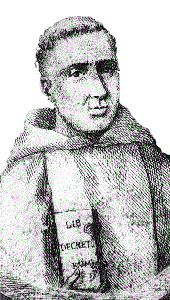Gratian, Concordia discordantium canonum
Gratian was a teacher of canon law in Bologna around 1140. He compiled his own textbook which he called Concordia discordantium canonum ("Harmony from Discordant Canons"). The work became know as the Decretum for short, thus signaling his intention to reconcile systematically contradictory statements of ecclesiastical law.

The Decretum was produced in a two-stage process, with Gratian himself finishing a first recension at some point probably soon after 1139, before being made Bishop of Chiusi in Tuscany, where he appears to have died on 10 August, c. 1145. This first recension contained 1860 canons which Gratian discussed in almost 1000 discursive comments (“dicta”) of varying length. He began by discussing the characteristics of law and then clerical office and life in a long treatise as yet without subdivisions. He divided the rest of the Decretum into 36 causae (“cases”), each of which describes an imagined situation from which Gratian derived and discussed up to eleven legal questions. The first causa is devoted to simony, the sin of selling ecclesiastical office. Causae 2-8 concern legal procedure, while later causae treat ecclesiastical property and tithes, monastic law, oaths, just war, and heresy. The last quarter of his work, causae 27-36 makes up a substantial treatise on marriage law, into which Gratian inserted, as causa 33, quaestio 3, a long and innovative treatise on penance.
We might imagine that Gratian left teaching abruptly, never finishing and polishing his collection. His successors thought the work was incomplete, so they added some 2000 further chapters to it, drawn mainly from the same sources as Gratian had used for the first recension. Their additions are distributed across the entire Decretum and include rather few dicta, often making the second recension appear a less tightly argued work than the first. Somewhat later, they added the third part of the Decretum, known as de consecratione, a collection of canons (but no dicta) concerning such sacramental law (baptism, confirmation, consecration of church buildings and objects) as Gratian had not treated in the first recension.
The text of the Decretum was subject to even more editorial work over several decades after the completion of the second recension. Some two hundred chapters were added, often drawing on Burchard's Decretum, which had not been used for either the first or the second recension. These additions are called paleae (chaff, in distinction from the grain of the rest of the work). In some cases editorial work cancelled canons that were duplicated or otherwise less desirable. The cancelled canons are, confusingly, also called paleae, although some scholars refer to them as duplicates instead.
Gratian's Decretum (GR) was added to the database in 2021; it is currently found in the beta version only https://beta.mgh.de/databases/clavis/db/search?context=10&key=GR1.001.01.000
The analysis in the Clavis database is based on Friedberg's edition.
Earlier editions
Gratian's work was first printed by Heinrich Eggestein of Strasbourg in 1471 (Copy of Bodleian Library, Oxford, vol. 1 and 2, available online).
Literature
Winroth, Making
Categories
Category:Clavis entries based on modern edition
New Collection
